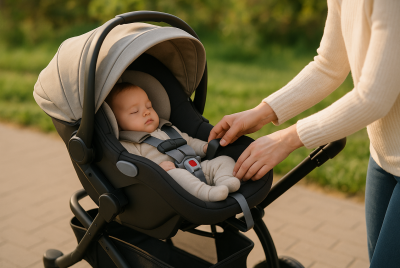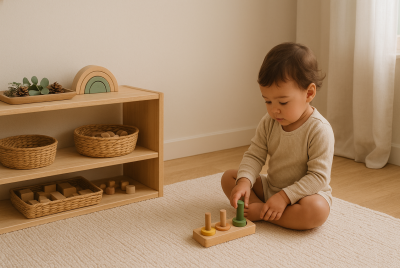Back-to-School Prep Timeline (Starting in July!)
We may earn a commission for purchases made using our links. Please see our disclosure to learn more.
Summer blurs in a beautiful way—bare feet, late dinners, sticky hands, and a sense that time doesn’t quite exist. Then suddenly, it’s the last week of August and you’re in a fluorescent-lit aisle negotiating for the last set of dividers like it’s a rare artifact. This year, let’s skip the scramble. With a calm, step-by-step Back-to-School Prep plan that starts in July, you’ll spread out the cost, tame the chaos, and walk into the first week with your shoulders down and your smile up.
What you’ll get here: a simple week-by-week timeline, practical tips, mom-/dad-tested hacks, five Amazon product picks (with pros/cons and a comparison table), a research-backed section with credible sources, FAQs, and a short, encouraging send-off. Ready to feel organized—and even a little proud? Let’s do it together.
July Week 1: Set Goals & Budget
Think of this as your preseason huddle. Decide what “smooth” looks like for your family this year: calmer mornings, healthier lunches, less homework drama, on-time bedtime—name it so you can plan for it.
How to set a simple budget
- List the big buckets: supplies, clothes/shoes, lunch gear, tech, activities.
- Assign a ballpark amount to each and set calendar reminders to shop during sales.
- Tip: Stash a small “surprise expenses” fund for the teacher’s last-minute request or the field-trip fee.
Reflection: What’s the one thing that made last August stressful? How can you budget or plan for it now?
July Week 2: Audit Closets & Supplies
Before you buy, “shop your house.”
Quick audit checklist (15 minutes per kid)
- Closet: Try-on pile (keep), too-small pile (donate), too-worn pile (recycle).
- Desk/backpack: Pens that still write, notebooks with unused pages, calculators that still power on.
- Shoes: If they fit now but not for long, size up on the next pair.
Tiny win: You’ll instantly reduce your shopping list—aka money saved.
July Week 3: Health Checkups, Forms & Records
School nurses are heroes, but they can’t chase every family for paperwork.
Book now, breathe later
- Pediatric/dental/vision appointments and sports physicals.
- Update immunization records, allergy plans, and emergency contacts.
- Snap photos of documents for a shared family folder (Google Drive/Notes app).
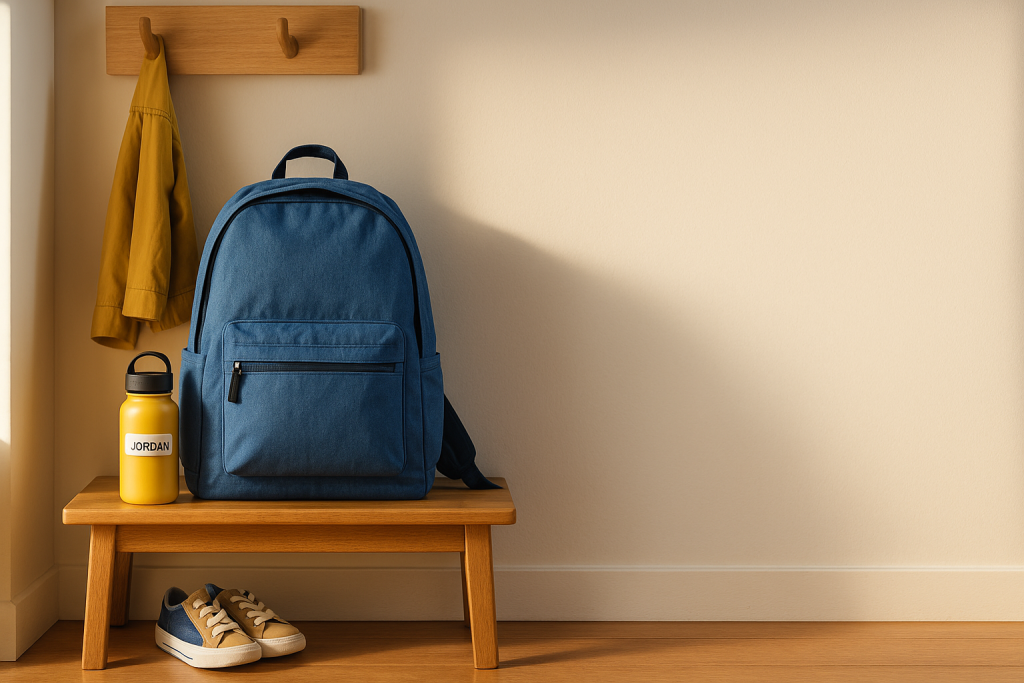
July Week 4: Order Core Supplies Online
Beat the rush. Prices are reasonable, stock is plentiful, and you can click from your couch.
What to buy early
- Writing basics: pencils, erasers, highlighters.
- Paper goods: wide/college-ruled notebooks, binders, dividers.
- Organizers: pencil cases, folders, zipper pouches for small items.
Pro move: Grab extras of the always-lost items (pencils, erasers, glue sticks). Future-you will cheer.
Early August: Smart Shopping Strategy
This is the sweet spot for sales.
Make stores work for you
- Compare bundles vs. singles. A class pack might be cheaper.
- Color-code by kid. Blue for one child, green for another—fewer mix-ups.
- Receipts in one envelope. Easy exchanges if teachers specify different brands.
Mid-August: Tech Check & Digital Safety
Today’s pencil case is part USB cable, part headphones, part calculator.
Run a quick tech audit
- Update software, replace frayed charging cables, test the calculator.
- Add parental controls and rehearse “screen-off” rules for weeknights.
- Label everything—chargers vanish faster than pencils.
Mid-August: Set Up the Homework Station
A calm corner signals, “This is where focus happens.”
Build a no-drama setup
- Good task lighting, comfy chair, and a bin with essentials (pencils, sticky notes, timer).
- A wall calendar or whiteboard for due dates and after-school activities.
- Noise options: earplugs, headphones, or a white-noise app if your home is lively.
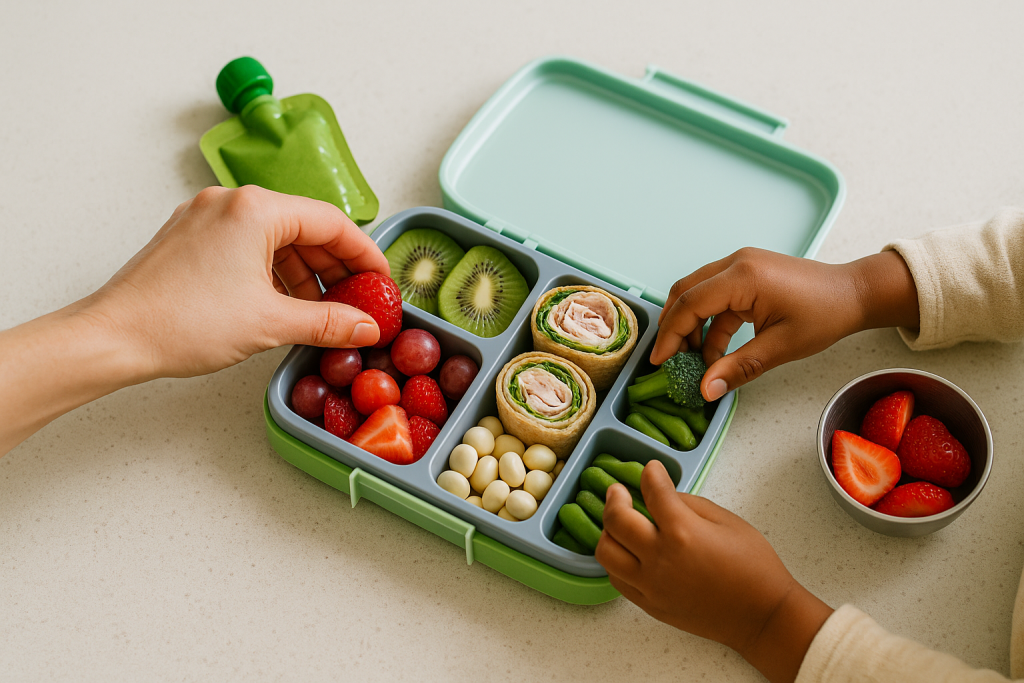
Late August: Sleep Schedule & Morning Routine Reset
Circadian rhythms don’t pivot on a dime.
Gentle reset plan (start 10–14 days out)
- Move bedtime and wake time 15 minutes earlier every 2–3 days.
- Create a short, repeatable evening sequence (shower → lay out clothes → pack backpack → wind-down reading).
- Morning “flow”: wake → drink water → quick stretch → dress → breakfast → out the door.
- Keep it simple, keep it consistent.
Analogy that helps kids: “We’re tuning our body clocks like tuning a guitar—little turns, better music.”
Late August: Lunch Gear, Meal Prep & Pantry Plan
Hungry kids learn less; systems make lunch easy.
Gear that saves sanity
- Bento-style lunch box, insulated thermos, reusable snack bags, and a sturdy water bottle.
- Practice opening containers—independence = faster lunch.
Two-week pantry plan
- Shelf-stable sides (crackers, fruit cups), freezable mains (mini burritos), and grab-and-go produce (apples, seedless grapes).
- Sunday prep: wash produce, portion snacks, pre-fill water bottles.
Transportation Plan: Bus, Carpool, or Walk
No one enjoys first-week traffic surprises.
Map it out
- Confirm bus route and pickup time.
- Exchange contacts for carpools; set a default schedule and a backup.
- If walking, do a practice route and review crosswalk rules.
Learning Warm-Ups: Gentle Academic Refreshers
No marathon worksheets. Just light “brain stretching.”
15-minute ideas
- Read together or audiobooks while cooking.
- Quick math facts with a whiteboard race.
- A “curiosity jar” of topics to Google together after dinner.
Question to ask your child: “What do you hope you’ll learn this year?”

Emotional Prep: Big Feelings, New Starts
New teacher, new friends, new routines—big feelings are normal.
Simple support strategies
- Do a school walk-through if allowed; visit the classroom door and the cafeteria.
- Share a story about a time you felt nervous and what helped.
- Create a pocket note for day one (“You’ve got this. Love, me.”).
Inclusive note: For bilingual families, practice morning phrases in both languages—comfort meets confidence.
Labeling & Organization Hacks That Save Sanity
Future-you loves labels.
What to label (really)
Backpack, lunch gear, jackets, water bottle, pencil case, tech accessories, and the inside tag of “that hoodie they always lose.”
Tiny systems that pay off
- A landing zone by the door (hooks + basket).
- A Sunday reset: empty backpacks, restock supplies, sign forms.
Communication Setup: Teachers, Calendars & Apps
Clarity reduces stress.
Do these before day one
- Add school events to your digital calendar (bell times, breaks, parent nights).
- Decide your family’s message channel (shared calendar, group chat, fridge whiteboard).
- Draft a short intro email to the teacher: name, pronouns, preferred contact, any helpful notes.
Special Cases: Multiple Kids, New Schools & Neurodiversity
One size does not fit all.
What helps
- Multiple kids: Color-code folders, assign each a shelf or cubby.
- New school: Watch a student-made tour on YouTube together; look up the map.
- Neurodiverse learners: Preview transitions with photos, visual schedules, and clear sensory plans (ear defenders, wiggle seats, fidget tools).
The Weekend Before: Dress Rehearsal for Day One
Make the first morning feel familiar.
Quick run-through
- Lay out outfits, pack bags, set alarms, test the breakfast plan.
- Drive or walk the route at the real time you’ll leave.
- End Sunday with something soothing: pajamas early, chapter book, lights low.
Amazon Back-to-School Essentials (Affiliate Picks)
Below are five parent-beloved products by name. Use them as-is or as a checklist for similar options.
1) JanSport SuperBreak One Backpack
Why it’s a staple: Lightweight, tough, and simple—kids actually use every pocket.
Features: 600-denier fabric, large main compartment, front utility pocket, straight-cut shoulder straps.
Pros: Durable, classic look, tons of colors.
Cons: Minimal padding for laptops.
Best for: Elementary through early high school.
What reviewers note: Holds up all year; zippers rarely snag.
2) Crayola Colored Pencils, 24-Count
Why kids love them: Smooth color that doesn’t fight the paper.
Features: Pre-sharpened, break-resistant cores.
Pros: Vibrant, blendable, affordable.
Cons: Not washable (they’re pencils).
Best for: Art class, projects, calm-down coloring.
What reviewers note: Consistent quality across sets.
3) Bentgo Kids Leak-Proof Lunch Box
Why it’s a parent favorite: One container, built-in portions, fewer single-use bags.
Features: Five compartments, removable tray, dishwasher safe.
Pros: Leak-resistant, kid-friendly latches, easy to clean.
Cons: Bulky in small backpacks.
Best for: Preschool to grade school; picky eaters who like variety.
What reviewers note: Minimal mess, encourages balanced lunches.
4) Texas Instruments TI-30XIIS Scientific Calculator
Why teachers recommend it: It’s allowed in many classes and exams, and it just works.
Features: Solar + battery, two-line display, and fraction/percentage features.
Pros: Affordable, durable, widely accepted.
Cons: Not programmable.
Best for: Middle/high school math and science.
What reviewers note: Easy learning curve, reliable for multiple years.
5) Paper Mate Clearpoint Mechanical Pencils (0.7mm), 12-Pack
Why students reach for them: Comfortable grip, click-top eraser, clean lines.
Features: Refillable lead/eraser, textured barrel.
Pros: Smooth writing, fewer smudges, refillable.
Cons: Easier to misplace than wood pencils.
Best for: Daily notes, homework, standardized test prep.
What reviewers note: “Writes like a gel pen but erasable.”
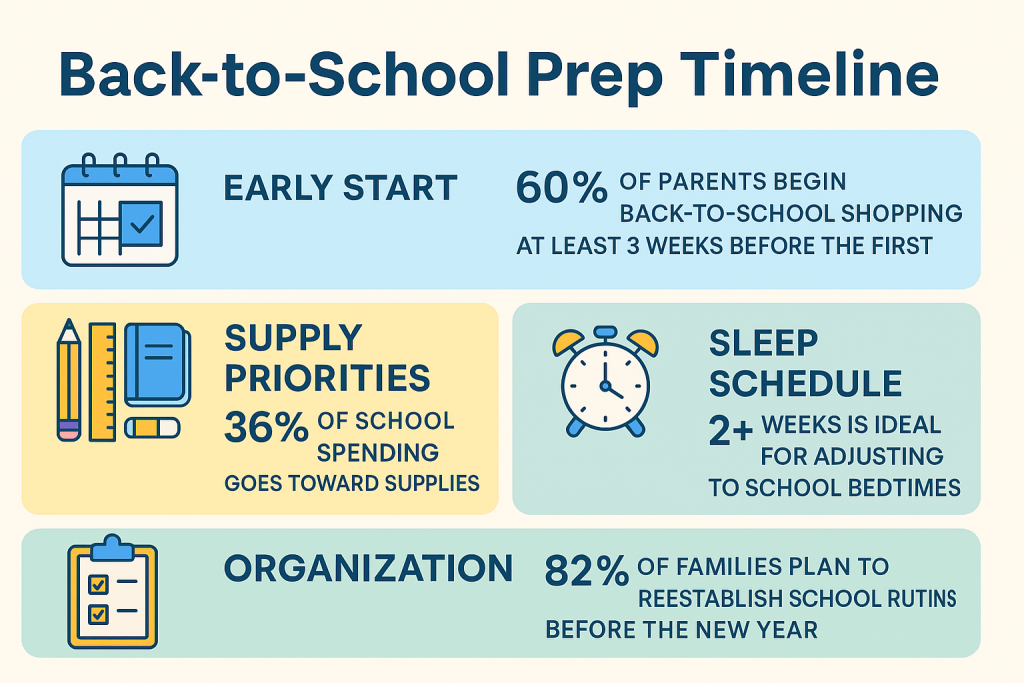
Side-by-Side Comparison Table
| Product | Best For | Standout Features | Pros | Cons | Price Range* |
| JanSport SuperBreak One Backpack | Daily carry (Elem–HS) | 600D fabric, front pocket | Durable, lightweight | Minimal laptop padding | $$ |
| Crayola Colored Pencils (24) | Art & projects | Pre-sharpened, blendable | Vibrant, affordable | Not washable | $ |
| Bentgo Kids Lunch Box | Lunch variety | 5 leak-resistant compartments | Easy clean, portioned | Bulky in small bags | $$ |
| TI-30XIIS Calculator | Math/science (MS/HS) | Two-line, solar+battery | Exam-friendly, durable | Not programmable | $$ |
| Paper Mate Clearpoint 12-Pack | Everyday writing | 0.7mm, refillable | Smooth, comfy grip | Easy to misplace | $ |
*Price symbols are relative ($ low, $$$ higher). Check current pricing.
Research-Backed Insights: What Works (and Why)
Sleep and start times matter. A 2022 meta-analysis in Pediatrics found that later middle/high school start times are associated with better sleep duration, attendance, mood, and academic outcomes, with start times between 8:30–8:59 a.m. outperforming 8:00–8:29 a.m. districts. The takeaway for families—especially when you can’t change the bell schedule—is to prioritize consistent bed/wake times and protect sleep like a varsity sport.
Family routines support readiness. A 2024 systematic review concluded that predictable routines (bedtime, mealtime, and transition rituals) are linked with positive child outcomes across cognitive, self-regulation, social-emotional, and academic domains. In real life, this looks like a steady evening sequence and a repeatable morning flow so kids know what’s next—and their nervous systems can relax.
Extra resources: The CDC emphasizes that adequate sleep improves focus and academic performance, and encourages consistent sleep schedules and strong “sleep hygiene” (dim lights, device limits) during the school year. Consider these recommendations as you reset bedtime in late August.
FAQs: Quick Answers Parents Search For
When should I start Back-to-School Prep?
Begin in early July to spread purchases and avoid August stockouts. Use late July for clothing/gear audits and August for sales, routine resets, and tech checks.
What’s the most overlooked item on the school supplies checklist?
Labels—for backpacks, lunch gear, water bottles, jackets, and chargers. Also: extra pencils/erasers for the mid-semester slump.
How do I fix chaotic mornings?
Create a five-step morning flow (wake, hydrate, dress, breakfast, out the door). Prep the night before: outfits, packed bags, signed forms parked in a “launch zone.”
How can I keep lunches fresh without fancy meal prep?
Pick three rotating mains (thermos pasta, mini burritos, DIY snack box), add two fruits/veg, and staple sides. Pre-portion snacks on Sunday; keep a “grab shelf” in the fridge.
My teen won’t fall asleep earlier—help?
Shift bedtime gradually (15 minutes every few days), dim lights an hour before bed, and park devices outside the bedroom. If start times are early, prioritize a consistent schedule and a short morning light exposure (open the curtains).
Helpful Resource for Newer Parents
If you’re transitioning from preschool routines to elementary rhythms, this compassionate guide offers bite-sized mindset and logistics tips: practical advice for new parents.
Conclusion: A Calmer, Kinder Start
You don’t need a label maker for your soul—but it helps to label what matters. Start small in July, keep your lists light and flexible, and let routines carry some of the weight. When the first bell rings, your family won’t feel yanked from summer; you’ll feel guided into the new season—less rush, more rhythm, and room for joy.
You’ve got this. And your kids? They’ll feel it, too.


